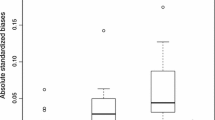Abstract
In this paper, we propose a variable transformation way and obtain the optimal stop-loss reinsurance under value at risk (VaR) and conditional tail expectation (CTE) criteria, respectively. Let X be the initial loss of an insurer with cumulative distribution function \(F_X(x)=P(X\le x)\) and survival function \(S_X(x)=1-F_X(x)\). Denote a transformation variable \(Y=-\,\ln (S_X(X))\). Firstly, we analyze properties of the variables X and Y. Then, under VaR- and CTE-optimization criteria, we provide the necessary and sufficient conditions for the optimal retention existence of Y, respectively. Further, the optimal retention of X is obtained. Some examples are given to illustrate these results.






Similar content being viewed by others
References
Arrow, K. J. (1963). Uncertainty and the welfare economics of medical care. American Economic Review, 53(5), 941–973.
Artzner, P., Delbean, F., Eber, J. M., & Health, D. (1997). Thinking coherently. Risk, 10(11), 68–71.
Artzner, P., Delbean, F., Eber, J. M., & Health, D. (1999). Coherent measures of risks. Mathematical Finance, 9(3), 203–208.
Asimit, A. V., Furman, E., Tang, Q., & Vernic, R. (2011). Asymptotics for risk capital allocations based on conditional tail expectation. Insurance: Mathematics and Economics, 49(3), 310–324.
Basak, S., & Shapior, A. (2001). Value-at-risk-based risk management: Optimal policies and asset prices. The Review of Financial Studies Summer, 14(2), 371–405.
Borch, K. (1960). An attempt to determine the optimum amount of stop loss reinsurance. In Transactions of the 16th international congress of actuaries (Vol. I, pp. 597–610).
Cai, J., & Tan, K. S. (2007). Optimal retention for a stop-loss reinsurance under the VaR and CTE risk measures. Astin Bulletin, 37(1), 93–112.
Cai, J., Tan, K. S., Weng, C., & Zhang, Y. (2008). Optimal reinsurance under VaR and CTE risk measures. Insurance: Mathematics and Economics, 43(1), 185–196.
Cai, J., Lemieux, C., & Liu, F. (2014). Optimal reinsurance with regulatory initial capital and default risk. Insurance Mathematics annd Economics, 57(1), 13–24.
Chi, Y., & Tan, K. S. (2013). Optimal reinsurance with general premium principles. Insurance: Mathematics and Economics, 52(2), 180–189.
Chi, Y., & Weng, C. (2013). Optimal reinsurance subject to Vajda condition. Insurance: Mathematics and Economics, 53(1), 179–189.
Chun, S. (2005). Probability theory (2nd ed.). Beijing: Science Press.
Duffie, D., & Pan, J. (1997). An overview of value at risk. Journal of Derivatives, 4(3), 7–49.
Föllmer, H., & Schied, A. (2004). Stochastic finance: An introduction in discrete time (2nd revised and extended edition). Berlin: Walter de Grutter.
Hu, X., Yang, H., & Zhang, L. (2015). Optimal retention for a stop-loss reinsurance with incomplete information. Insurance Mathematics and Economics, 65(6), 15–21.
Landsman, Z., & Valdez, E. A. (2005). Tail conditional expectations for exponential dispersion models. Astin Bulletin, 35(1), 189–209.
Kaluszka, M. (2001). Optimal reinsurance under mean-variance premium principles. Insurance: Mathematics and Economics, 28(1), 61–67.
Kaluszka, M., & Okolewski, A. (2008). An extension of Arrow’s result on optimal reinsurance contract. The Journal of Risk and Insurance, 75(2), 275–288.
Kaas, R., Goovaerts, M., Dhaene, J., & Denuit, M. (2001). Modern acturial risk theory. Boston: Kluwer Academic Publishers.
Ohlin, J. (1969). On a class of measures of dispersion with application to optimal reinsurance. Astin Bulletin, 5(2), 249–266.
Young, V. R. (1999). Optimal insurance under wangs premium principle. Insurance Mathematics and Economics, 25(2), 109–122.
Zhou, X., Zhang, H., & Fan, Q. (2015). Optimal limited stop-loss reinsurance under VaR, TVaR, and CTE risk measures. Mathematical Problems in Engineering, 2015, 1–12.
Acknowledgements
This work is supported by the Natural Science Foundation of Xinjiang (Grant No. 2016D01C043) and the Natural Science Foundation of China (Grant Nos. 11361058, 11661076).
Author information
Authors and Affiliations
Corresponding author
Rights and permissions
About this article
Cite this article
Du, J., Li, Z. & Wu, L. Optimal Stop-Loss Reinsurance Under the VaR and CTE Risk Measures: Variable Transformation Method. Comput Econ 53, 1133–1151 (2019). https://doi.org/10.1007/s10614-017-9778-1
Accepted:
Published:
Issue Date:
DOI: https://doi.org/10.1007/s10614-017-9778-1




